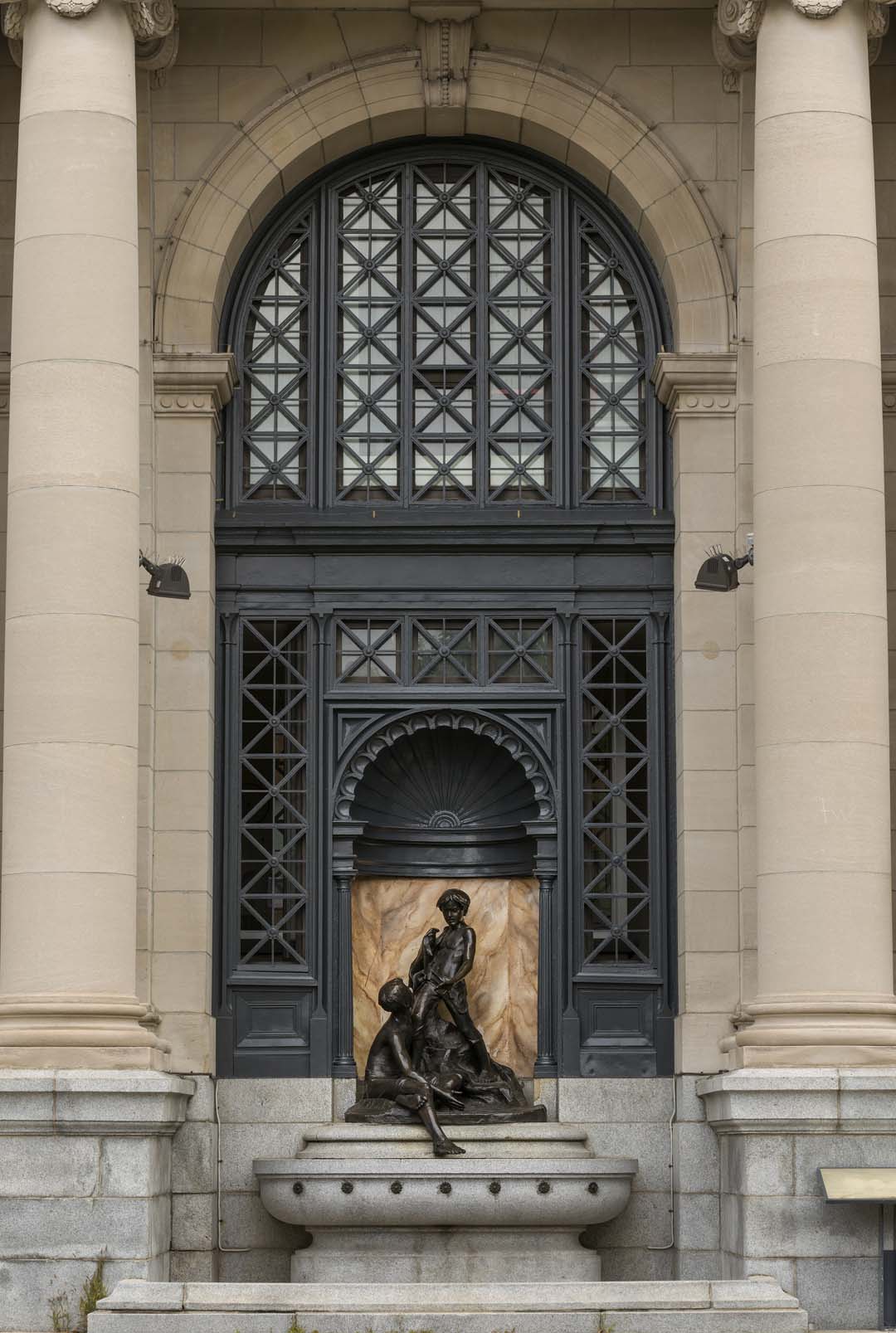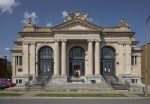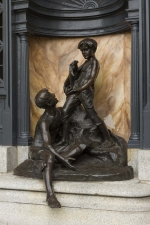Alfred Laliberté
Les petits baigneurs
1916
Presentation of the artwork
Les petits baigneurs is a bronze sculpture portraying a contemporary bathing scene. A sitting person is splashing a standing person, who doesn’t seem to be enjoying the game. The asymmetrical composition, part of which projects beyond the niche formed of a shell and two fluted columns, creates a sense of dynamism.Produced at a time when Laliberté was gaining recognition for his commemorative sculptures, the fountain reflects his interest in Québec folklore. In fact, the theme reflects the function of the site, but displaces the activity that took place at a city baths to a rural context.
There is a similar displacement in Laliberté’s La fermière, an artwork that had been installed a few steps away from Les petits baigneurs, in front of the Maisonneuve market, the previous year. The secondary statuary groups in this other fountain represent three boys, expressed rather stiffly, taking animals to the market. Thus, both works give a sense of the transition from rural to urban life.
Associated events
Commissioned in 1915 by the Cité de Maisonneuve to adorn the façade of the Maisonneuve baths and gymnasium (today Morgan Baths), the artwork illustrates the aesthetic and social concerns that characterized the urban plan of the city at the time.
Alfred Laliberté
Born in 1878 in Sainte-Élizabeth-de-Warwick, in the Bois-Francs region, Alfred Laliberté received training at the Conseil des arts et manufactures in Montréal; when he was 23, he went to study at the prestigious École des beaux-arts de Paris. He returned to Canada in 1907 and became a professor at the École des beaux-arts de Montréal in 1922.
A prolific artist, Laliberté produced more than 920 sculptures. Some were portrayals of important historical figures, including statues of Father Brébeuf and Father Marquette in Québec City, whereas others evoked rural traditions and legends, such as the series of bronzes commissioned by the Québec government in 1928. Laliberté was long regarded as Québec’s “national sculptor”.
A prolific artist, Laliberté produced more than 920 sculptures. Some were portrayals of important historical figures, including statues of Father Brébeuf and Father Marquette in Québec City, whereas others evoked rural traditions and legends, such as the series of bronzes commissioned by the Québec government in 1928. Laliberté was long regarded as Québec’s “national sculptor”.
Awards and honours
- doctorat Honoris Causa, Université de Montréal. , 1940
Presentation of the artwork
Les petits baigneurs is a bronze sculpture portraying a contemporary bathing scene. A sitting person is splashing a standing person, who doesn’t seem to be enjoying the game. The asymmetrical composition, part of which projects beyond the niche formed of a shell and two fluted columns, creates a sense of dynamism.Produced at a time when Laliberté was gaining recognition for his commemorative sculptures, the fountain reflects his interest in Québec folklore. In fact, the theme reflects the function of the site, but displaces the activity that took place at a city baths to a rural context.
There is a similar displacement in Laliberté’s La fermière, an artwork that had been installed a few steps away from Les petits baigneurs, in front of the Maisonneuve market, the previous year. The secondary statuary groups in this other fountain represent three boys, expressed rather stiffly, taking animals to the market. Thus, both works give a sense of the transition from rural to urban life.
Associated events
Commissioned in 1915 by the Cité de Maisonneuve to adorn the façade of the Maisonneuve baths and gymnasium (today Morgan Baths), the artwork illustrates the aesthetic and social concerns that characterized the urban plan of the city at the time.
Alfred Laliberté
Born in 1878 in Sainte-Élizabeth-de-Warwick, in the Bois-Francs region, Alfred Laliberté received training at the Conseil des arts et manufactures in Montréal; when he was 23, he went to study at the prestigious École des beaux-arts de Paris. He returned to Canada in 1907 and became a professor at the École des beaux-arts de Montréal in 1922.
A prolific artist, Laliberté produced more than 920 sculptures. Some were portrayals of important historical figures, including statues of Father Brébeuf and Father Marquette in Québec City, whereas others evoked rural traditions and legends, such as the series of bronzes commissioned by the Québec government in 1928. Laliberté was long regarded as Québec’s “national sculptor”.
A prolific artist, Laliberté produced more than 920 sculptures. Some were portrayals of important historical figures, including statues of Father Brébeuf and Father Marquette in Québec City, whereas others evoked rural traditions and legends, such as the series of bronzes commissioned by the Québec government in 1928. Laliberté was long regarded as Québec’s “national sculptor”.
Awards and honours
- doctorat Honoris Causa, Université de Montréal. , 1940






